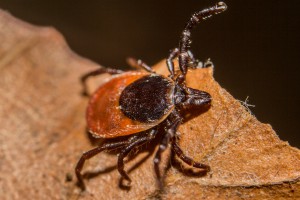
Infectious diseases are considered to be “emerging” or “re-emerging” if they have increased in incidence in the previous two decades or if they threaten to increase in the near future. The causes of infectious disease emergence vary but include the development of resistance of pathogens, increased global trade and travel, increased public awareness, climate change, enhanced levels of surveillance or enhanced surveillance methodologies, socioeconomic change and the perturbation of ecosystems.
Recently a number of novel vector-borne pathogens have been identified in the US. In 2009, two farmers were admitted to hospital in the Midwest US presenting with fever, fatigue, diarrhoea, thrombocytopenia, and leukopenia. Both men had been bitten by ticks in the preceding week. Initially ehrlichiosis was suspected, however electron microscopy and whole genome sequencing revealed the presence of a novel Phlebovirus (family: Bunyaviridae). This virus is thought to be the first pathogenic Phlebovirus discovered in the US and was named Heartland virus.
Phleboviruses are a diverse group of viruses, some of which are pathogens of humans and animals (such as Rift Valley Fever) and are vectored by sandflies, mosquitoes and ticks.
Phylogenetic analysis of the genome of the Heartland Virus suggested it was most closely related to another recently described Phlebovirus in China that is associated with severe fever with thrombocytopenia syndrome (SFTS) which is thought to be transmitted by ticks.
More recently, a study published in September 2013 issue of the American Journal of Tropical Medicine and Hygiene collected 56,428 ticks from 12 sites across Missouri including farms where case-patients of the Heartland virus study originated. Ten tick pools tested positive for the presence of the pathogen implicating the tick, Amblyomma americanum, as a potential vector. Moreover, phylogenetic analysis revealed that the strains collected from ticks and patients shared more than 97.6% sequence identity and that nine of the ten tick pools infected with Heartland virus were from a case-patients farm, further supporting the role of ticks in the transmission cycle.
The discovery of Heartland virus in the Midwest comes in addition to the discovery of a novel Ehrlichia species also in the Midwest in 2009 . Prior to this only two species of Ehrlichia (E. chaffeensis and E. ewingii) were thought to cause human ehrlichiosis in the US, along with the closely related Anaplasma phagocytophilum which causes a similar febrile illness, anaplasmosis. In this study, the blood of 4,247 patients with suspected ehrlichiosis/anaplasmosis from 45 states with were screened for the presence of these pathogens by real-time PCR. While the majority of patients were infected with these previously recognised pathogens, four patients from the Midwest produced abnormal results and were found to be infected with a novel Ehrlichia species most closely related to E. muris. Moreover, this novel Ehrlichia species was detected in Ixodes scapularis ticks collected from vegetation in the Wisconsin and Minnesota area, implicating this tick species as a possible vector of this novel pathogen.
The extent to which these novel tick-borne pathogens emerge will only become apparent with continued surveillance and experimental studies will be required to definitively identify the vectors of these pathogens. The identification of novel tick-borne pathogens associated with clinical syndromes in the US and elsewhere suggests that tick-borne pathogens continue to emerge and the discovery of these pathogens in the Midwest adds to the ever growing list of vector-borne human pathogens.

Nice piece on tick-borne diseases, Alan. Do you know if these novel pathogens are restricted to Missouri or the Midwest, or if they could be more widespread in the US? I was listening to a CDC/NACCHO webinar recently about tick-borne diseases that was very interesting. It looks to me that ticks are potentially much more dangerous vectors in relation to mosquitoes. A very large proportion of ticks (up to 90%) can harbor infectious organisms, whereas only a few percent of mosquitoes will be infectious even during e.g. a large dengue outbreak.
The study on Heartland virus only examined ticks from the Midwest as this was the locations for the clinical cases so it’s currently not known if this pathogen is found elsewhere in the US. On the the other hand the study that identified a novel Ehrlichia species screened 4,247 samples from patients in 45 states, only 4/1,1518 samples were positive for the novel Ehrlichia, suggesting it’s range may be limited or at a very low prevalence elsewhere. Ticks generally don’t have very high prevalence of pathogens but what has also to be taken into account is the bite rate, ticks will only need three blood meals.
[…] of dengue in Florida (confirming that the disease had once more returned to the state) and the re-emergence of tick-borne diseases to the United […]